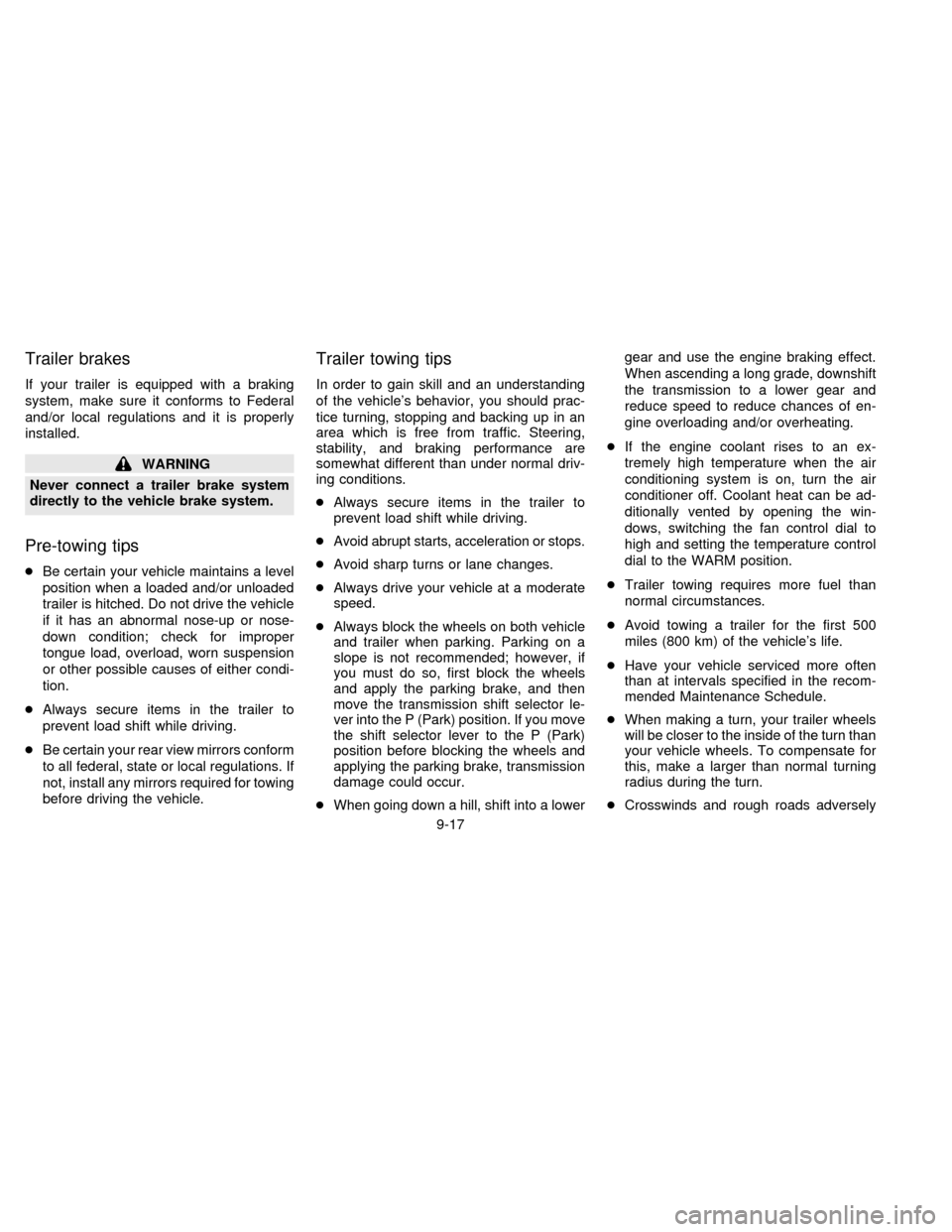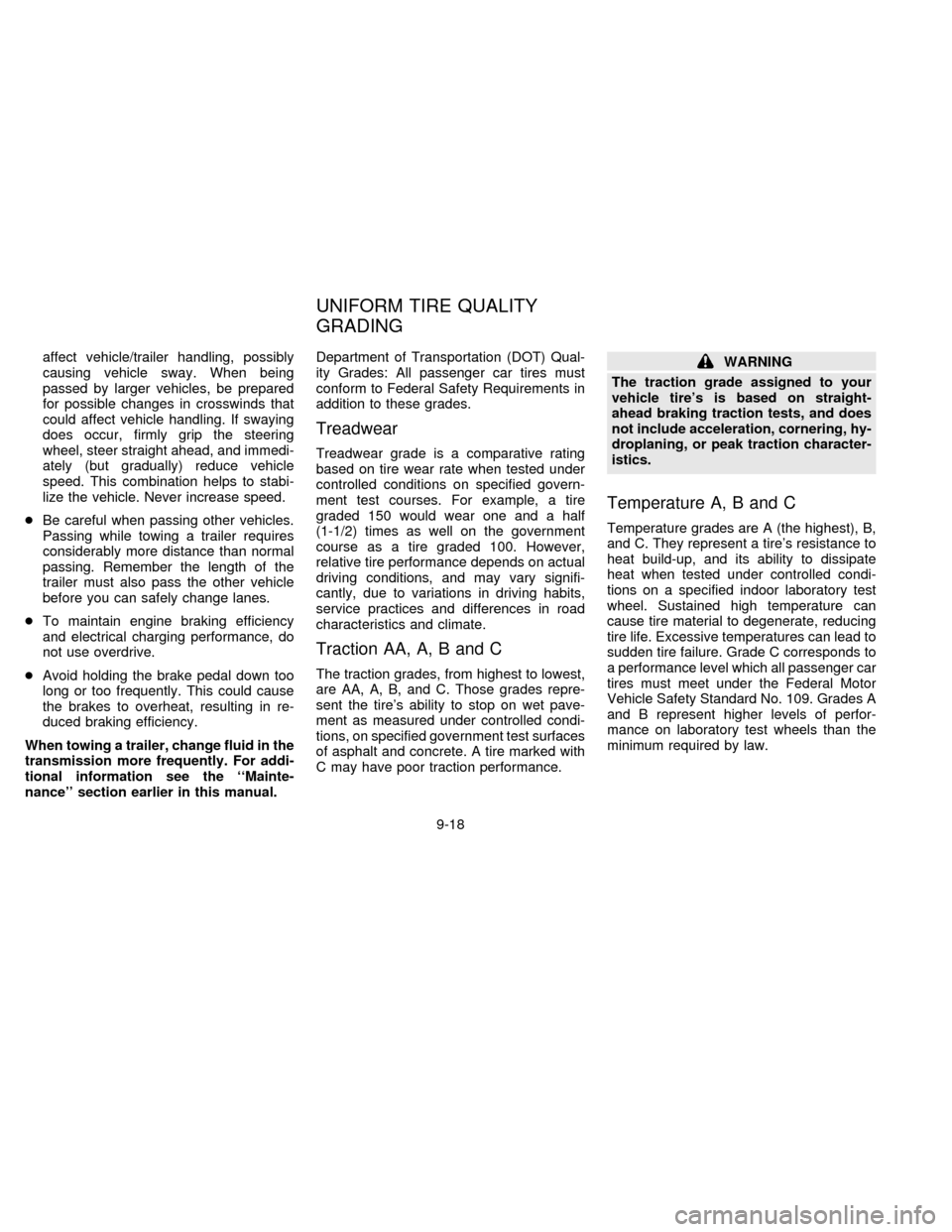1997 NISSAN QUEST steering wheel
[x] Cancel search: steering wheelPage 210 of 247

make sure no nuts are missing, and check
for any loose nuts. Tighten if necessary.
Tire rotation*Ð Tires should be rotated
every 7,500 miles (12,000 km).
Wheel alignment and balanceÐIfthe
vehicle should pull to either side while driv-
ing on a straight and level road, or if you
detect uneven or abnormal tire wear, there
may be a need for wheel alignment.
If the steering wheel or seat vibrates at
normal highway speeds, wheel balancing
may be needed.
Windshield wiper blades*Ð Check for
cracks or wear if they do not wipe properly.
Doors and engine hoodÐ Check that all
doors and the engine hood operate prop-
erly. Also ensure that all latches lock se-
curely. Lubricate hinges, latches, rollers and
links if necessary. Make sure the secondary
latch keeps the hood from opening when
the primary latch is released.
When driving in areas using road salt or
other corrosive materials, check lubrication
frequently.INSIDE THE VEHICLE
The maintenance items listed here should
be checked on a regular basis, such as
when performing periodic maintenance,
cleaning the vehicle, etc.
Lights*Ð Make sure the headlights, stop
lights, tail lights, turn signal lights, and other
lights are all operating properly and installed
securely. Also check headlight aim.
Warning lights and buzzers/chimesÐ
Make sure all warning lights and
buzzers/chimes are operating properly.
Windshield wiper and washer*Ð Check
that the wipers and washer operate properly
and that the wipers do not streak.
Windshield defrosterÐ Check that the air
comes out of the defroster outlets properly
and in sufficient quantity when operating the
heater or air conditioner.
Steering wheelÐ Check for changes in
the steering conditions, such as excessive
freeplay, hard steering or strange noises.
SeatsÐ Check seat position controls such
as seat adjusters, seatback recliner, etc. to
ensure they operate smoothly and all
latches lock securely in every position.Check that the head restraints move up and
down smoothly and the locks hold securely
in all latched positions. Check that the seat
leg latches lock securely in every anchor
position for the folding down rear seat and
detachable rear seat (if so equipped).
Seat beltsÐ Check that all parts of the seat
belt system (e.g. buckles, anchors, adjust-
ers and retractors) operate properly and
smoothly, and are installed securely. Check
the belt webbing for cuts, fraying, wear or
damage.
Accelerator pedalÐ Check the pedal for
smooth operation and make sure the pedal
does not catch or require uneven effort.
Keep the floor mats away from the pedal.
BrakesÐ Check that the brakes do not pull
the vehicle to one side when applied.
Brake pedal*Ð Check the pedal for
smooth operation and make sure it has the
proper distance under it when depressed
fully. Check the brake booster function. Be
certain to keep floor mats away from the
pedal.
Parking brake*Ð Check that the pedal is
adjusted to specification and confirm that
your vehicle is held securely on a fairly
8-3
ZX
Page 236 of 247

Trailer brakes
If your trailer is equipped with a braking
system, make sure it conforms to Federal
and/or local regulations and it is properly
installed.
WARNING
Never connect a trailer brake system
directly to the vehicle brake system.
Pre-towing tips
cBe certain your vehicle maintains a level
position when a loaded and/or unloaded
trailer is hitched. Do not drive the vehicle
if it has an abnormal nose-up or nose-
down condition; check for improper
tongue load, overload, worn suspension
or other possible causes of either condi-
tion.
cAlways secure items in the trailer to
prevent load shift while driving.
cBe certain your rear view mirrors conform
to all federal, state or local regulations. If
not, install any mirrors required for towing
before driving the vehicle.
Trailer towing tips
In order to gain skill and an understanding
of the vehicle's behavior, you should prac-
tice turning, stopping and backing up in an
area which is free from traffic. Steering,
stability, and braking performance are
somewhat different than under normal driv-
ing conditions.
cAlways secure items in the trailer to
prevent load shift while driving.
c
Avoid abrupt starts, acceleration or stops.
cAvoid sharp turns or lane changes.
cAlways drive your vehicle at a moderate
speed.
cAlways block the wheels on both vehicle
and trailer when parking. Parking on a
slope is not recommended; however, if
you must do so, first block the wheels
and apply the parking brake, and then
move the transmission shift selector le-
ver into the P (Park) position. If you move
the shift selector lever to the P (Park)
position before blocking the wheels and
applying the parking brake, transmission
damage could occur.
cWhen going down a hill, shift into a lowergear and use the engine braking effect.
When ascending a long grade, downshift
the transmission to a lower gear and
reduce speed to reduce chances of en-
gine overloading and/or overheating.
cIf the engine coolant rises to an ex-
tremely high temperature when the air
conditioning system is on, turn the air
conditioner off. Coolant heat can be ad-
ditionally vented by opening the win-
dows, switching the fan control dial to
high and setting the temperature control
dial to the WARM position.
cTrailer towing requires more fuel than
normal circumstances.
cAvoid towing a trailer for the first 500
miles (800 km) of the vehicle's life.
cHave your vehicle serviced more often
than at intervals specified in the recom-
mended Maintenance Schedule.
cWhen making a turn, your trailer wheels
will be closer to the inside of the turn than
your vehicle wheels. To compensate for
this, make a larger than normal turning
radius during the turn.
cCrosswinds and rough roads adversely
9-17
ZX
Page 237 of 247

affect vehicle/trailer handling, possibly
causing vehicle sway. When being
passed by larger vehicles, be prepared
for possible changes in crosswinds that
could affect vehicle handling. If swaying
does occur, firmly grip the steering
wheel, steer straight ahead, and immedi-
ately (but gradually) reduce vehicle
speed. This combination helps to stabi-
lize the vehicle. Never increase speed.
cBe careful when passing other vehicles.
Passing while towing a trailer requires
considerably more distance than normal
passing. Remember the length of the
trailer must also pass the other vehicle
before you can safely change lanes.
cTo maintain engine braking efficiency
and electrical charging performance, do
not use overdrive.
cAvoid holding the brake pedal down too
long or too frequently. This could cause
the brakes to overheat, resulting in re-
duced braking efficiency.
When towing a trailer, change fluid in the
transmission more frequently. For addi-
tional information see the ``Mainte-
nance'' section earlier in this manual.Department of Transportation (DOT) Qual-
ity Grades: All passenger car tires must
conform to Federal Safety Requirements in
addition to these grades.
Treadwear
Treadwear grade is a comparative rating
based on tire wear rate when tested under
controlled conditions on specified govern-
ment test courses. For example, a tire
graded 150 would wear one and a half
(1-1/2) times as well on the government
course as a tire graded 100. However,
relative tire performance depends on actual
driving conditions, and may vary signifi-
cantly, due to variations in driving habits,
service practices and differences in road
characteristics and climate.
Traction AA, A, B and C
The traction grades, from highest to lowest,
are AA, A, B, and C. Those grades repre-
sent the tire's ability to stop on wet pave-
ment as measured under controlled condi-
tions, on specified government test surfaces
of asphalt and concrete. A tire marked with
C may have poor traction performance.
WARNING
The traction grade assigned to your
vehicle tire's is based on straight-
ahead braking traction tests, and does
not include acceleration, cornering, hy-
droplaning, or peak traction character-
istics.
Temperature A, B and C
Temperature grades are A (the highest), B,
and C. They represent a tire's resistance to
heat build-up, and its ability to dissipate
heat when tested under controlled condi-
tions on a specified indoor laboratory test
wheel. Sustained high temperature can
cause tire material to degenerate, reducing
tire life. Excessive temperatures can lead to
sudden tire failure. Grade C corresponds to
a performance level which all passenger car
tires must meet under the Federal Motor
Vehicle Safety Standard No. 109. Grades A
and B represent higher levels of perfor-
mance on laboratory test wheels than the
minimum required by law.
UNIFORM TIRE QUALITY
GRADING
9-18
ZX
Page 242 of 247

Audio controls (steering wheel) ............ 3-23
Heater and air conditioner controls
(automatic) ............................................ 3-10
Heater and air conditioner controls
(manual).................................................. 3-3
Rear seat heater and air conditioner
controls ................................................. 3-13
Coolant
Capacities and recommended fuel/
lubricants ................................................ 9-2
Changing engine coolant........................ 7-5
Checking engine coolant level ............... 7-4
Engine coolant temperature gauge ........ 1-4
Cornering light ........................................... 1-15
Corrosion protection .................................... 6-4
Cruise control............................................. 4-10
Cup holder ................................................. 1-18
D
Daytime running light system
(Canada only) ............................................ 1-13
Defogger switch
Rear window defogger switch .............. 1-12
Dimensions and weights.............................. 9-8
Door ajar warning light ................................ 1-7
Door locks .................................................... 2-2
Drive belts .................................................. 7-12
Driving
Cold weather driving............................. 4-16
Driving with automatic transmission ....... 4-5Precautions when starting and
driving ..................................................... 4-2
E
Economy - fuel........................................... 4-12
Emission control information label............. 9-10
Emission control system warranty ............. 9-19
Engine
Before starting the engine ...................... 4-5
Capacities and recommended fuel/
lubricants ................................................ 9-2
Changing engine coolant........................ 7-5
Changing engine oil................................ 7-6
Changing engine oil filter........................ 7-7
Checking engine coolant level ............... 7-4
Checking engine oil level ....................... 7-5
Engine compartment check
locations.................................................. 7-3
Engine coolant temperature gauge ........ 1-4
Engine cooling system ........................... 7-4
Engine oil ................................................ 7-5
Engine oil and oil filter
recommendation ..................................... 9-4
Engine oil pressure warning light ........... 1-6
Engine oil viscosity ................................. 9-5
Engine serial number ............................. 9-9
Starting the engine ................................. 4-8
Exhaust gas (Carbon monoxide) ................. 4-2F
Five passenger seating ............................. 2-18
Five passenger seating with cargo
room ........................................................... 2-18
Flashers (See hazard warning flasher
switch) ........................................................ 1-15
Flat tire ......................................................... 5-2
Flexible seating .......................................... 2-32
Floor mat positioning ........................ 2-17, 2-20
Floor mat positioning aid ........................... 2-20
Fluid
Automatic transmission fluid (ATF) ........ 7-8
Brake fluid ..................................... 7-10, 9-2
Capacities and recommended fuel/
lubricants ................................................ 9-2
Engine coolant ........................................ 7-4
Engine oil ................................................ 7-5
Power steering fluid ........................ 7-9, 9-2
Window washer fluid ............................ 7-10
F.M.V.S.S. certification label ..................... 9-10
Fuel
Capacities and recommended fuel/
lubricants ................................................ 9-2
Fuel economy ....................................... 4-12
Fuel filler lid and cap ............................ 2-15
Fuel filler lid lock opener lever ............. 2-15
Fuel gauge.............................................. 1-5
Fuel octane rating................................... 9-3
Fuel recommendation ............................. 9-2
Fuses ......................................................... 7-17
Fusible links ............................................... 7-18
10-2
ZX
Page 245 of 247

Seats
Five passenger seating ........................ 2-18
Five passenger seating with cargo
room...................................................... 2-18
Flexible seating..................................... 2-32
Integrated child safety seats ................ 2-71
Manual front seat adjustment ............... 2-26
Power support front seat ...................... 2-28
Seat positions ....................................... 2-21
Second row bench seat........................ 2-21
Second row bucket seats ..................... 2-24
Seven passenger seating ..................... 2-17
Sliding three-passenger seat................ 2-38
Three-passenger bench seat in fully
forward position .................................... 2-19
Three-passenger bench seat in storage
position ................................................. 2-17
Seats/floor mats ......................................... 2-15
Self-adjusting brakes ................................. 7-16
Service manual order form ........................ 9-21
Seven passenger seating .......................... 2-17
Shifting
Automatic transmission .......................... 4-6
Sliding three-passenger seat ..................... 2-38
Spark plug replacement............................. 7-12
Speedometer ............................................... 1-4
Spotlights ................................................... 1-25
SRS warning label ..................................... 2-47
Starting
Before starting the engine ...................... 4-5
Jump starting................................. 5-8, 7-12
Precautions when starting anddriving ..................................................... 4-2
Push starting......................................... 5-10
Starting the engine ................................. 4-8
Steering
Power steering fluid ........................ 7-9, 9-2
Tilting steering wheel............................ 2-78
Stop light .................................................... 7-21
Storage
Coin tray ............................................... 1-17
Compact disc storage........................... 1-18
Under seat storage tray........................ 2-31
Sun shade.................................................. 1-21
Sunroof ...................................................... 1-21
Supplemental restraint system
Information and warning labels ............ 2-47
Switch
Autolamp switch ................................... 1-13
Automatic power window switch .......... 1-20
Hazard warning flasher switch ............. 1-15
Headlight control switch ....................... 1-13
Ignition switch ......................................... 4-4
Overdrive switch ..................................... 4-7
Rear window defogger switch .............. 1-12
Rear window wiper and washer
switches ................................................ 1-12
Turn signal switch................................. 1-14
Windshield wiper and washer
switch .................................................... 1-11
T
Tabletop seats ........................................... 2-31Tachometer .................................................. 1-4
Theft warning ............................................. 1-10
Three way catalyst....................................... 4-2
Three-passenger bench seat..................... 2-57
Three-passenger bench seat in fully
forward position ......................................... 2-19
Three-passenger bench seat in storage
position....................................................... 2-17
Tilting steering wheel ................................. 2-78
Timing belt ................................................... 9-7
Timing chain ................................................ 9-7
Tire
Flat tire.................................................... 5-2
Spare tire .............................................. 7-29
Tire chains ............................................ 7-26
Tire placard........................................... 9-11
Tire pressure ........................................ 7-25
Tire rotation .......................................... 7-27
Tool kit .................................................... 5-2
Types of tires ........................................ 7-26
Uniform tire quality grading .................. 9-18
Wheels and tires ........................... 7-25, 9-8
Wheel/tire size ........................................ 9-8
Towing
Tow truck towing .................................. 5-12
Towing load/specification chart ............ 9-14
Trailer towing ........................................ 9-13
Transmission
Automatic transmission fluid (ATF) ........ 7-8
Driving with automatic transmission ....... 4-5
Travel (See registering your vehicle in
another country)........................................... 9-9
10-5
ZX